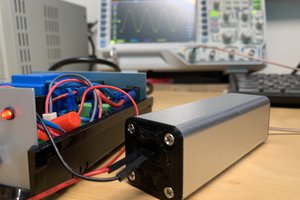The circuit uses an unusual way of lowering the battery's 12V output into an acceptable range suitable for the ATtiny85. Three zener diodes (reverse conducting) in series drop the battery voltage by a constant 6V. This allows the micro-controllers Vcc supply voltage to gradually drop as the battery discharges. As long as the voltage is above 1.8 volts the ATtiny85 is happy.

Despite being advised by several engineers that my circuit needs a voltage regulator I rejected this notion as unnecessary for this particular device (Christmas Tree Ornament). Although fed by an unstable voltage source the ATtiny85 is just as happy as long as the voltage stay's with-in it's operating limits which it does. The circuit works well until the battery voltage drops to around 7V and at this point the battery is dead.
The A23 battery is only 55mAh so power consumption was a big concern. This circuit draws only 11uA when all the LED's are turned off (and the ATtiny is put to sleep). The software is careful to only pulse the LED's for a few milliseconds at a time so that on average when running lighting patterns the circuit is only drawing around 0.2mA. This works out to 275 hours of continuous run time or 11.5 days.
An infinite number of LED patterns is generated by the code running on the ATtiny85. The battery voltage is read and used as a seed to the random number generator. The patterns are not simply random but are more like random sequenced patterns.
UPDATE: Note that the circuit schematic above using zener diodes to drop supply voltage is very unorthodox and not recommended. Each diode is somewhat unique and will give possibly unpredictable results. The recommended circuit uses a 12V to 5V voltage regulator to supply the ATtiny85 Vcc.

 Jeff Wahaus
Jeff Wahaus


 jaromir.sukuba
jaromir.sukuba


 Dr. Cockroach
Dr. Cockroach
Nice! Have you tried using an emitter follower configuration for the bjt on the leds?. (Connecting the base directly to the outputs of the attiny, the leds to the colector (no resistor) and a resistor in the emiter). That way you'd be making a voltage to current feedback amplifier, which is almost no dependant on the transistors hFE. The gain will be 1/Re (voltage to current).